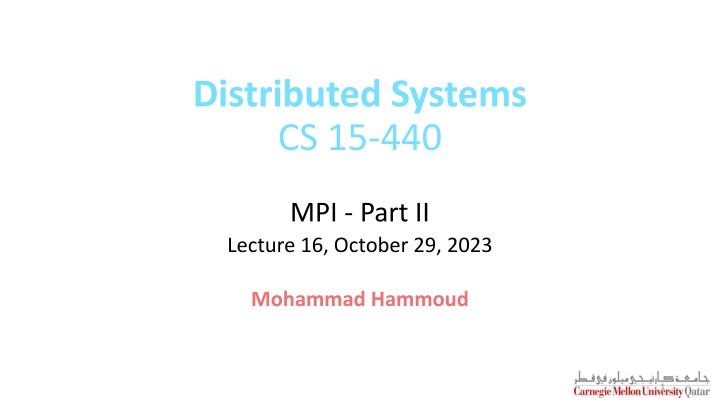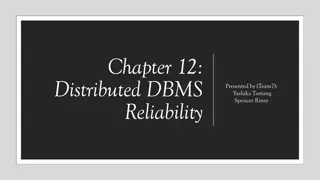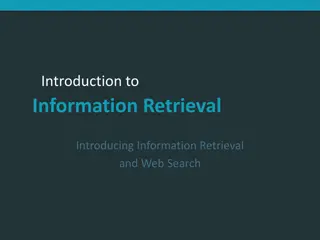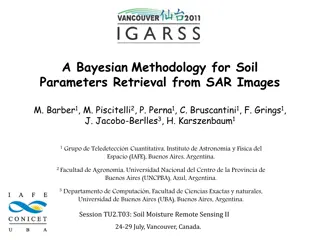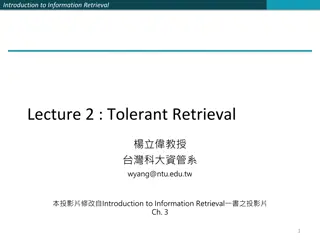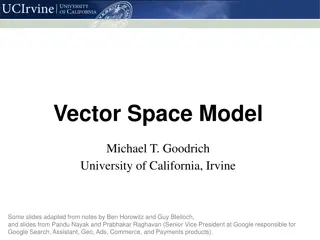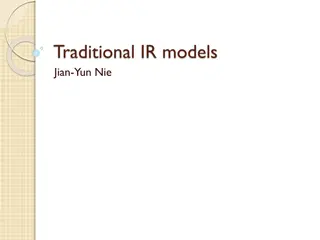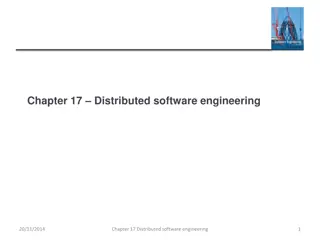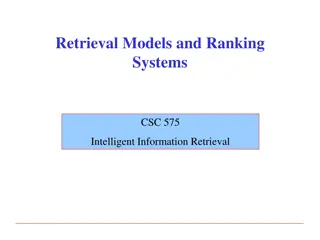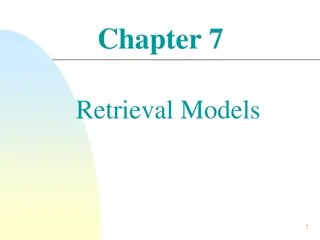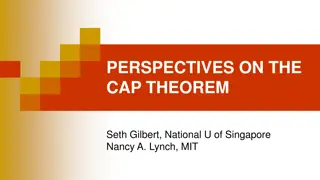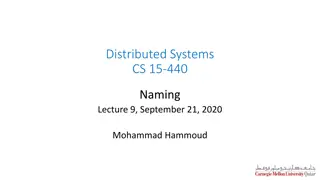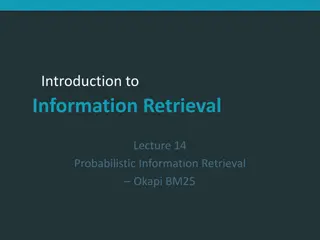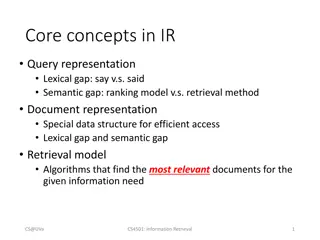Distributed Systems and Information Retrieval
Intersection of distributed systems and information retrieval, this content delves into various topics such as programming models, fault tolerance, replication, networking, and the complexities of information retrieval. Dive into the world of distributed systems and IR to understand the challenges and solutions in managing large data collections efficiently
Download Presentation

Please find below an Image/Link to download the presentation.
The content on the website is provided AS IS for your information and personal use only. It may not be sold, licensed, or shared on other websites without obtaining consent from the author.If you encounter any issues during the download, it is possible that the publisher has removed the file from their server.
You are allowed to download the files provided on this website for personal or commercial use, subject to the condition that they are used lawfully. All files are the property of their respective owners.
The content on the website is provided AS IS for your information and personal use only. It may not be sold, licensed, or shared on other websites without obtaining consent from the author.
E N D
Presentation Transcript
Distributed Systems CS 15-440 MPI - Part II Lecture 16, October 29, 2023 Mohammad Hammoud 1
Today Last Session: MPI Part I Today s Session: MPI Part II Announcement: P3 is out. It is due on Nov 16
Course Map Applications Programming Models Fast & Reliable or Efficient DS Replication & Consistency Fault-tolerance Communication Paradigms Architectures Naming Synchronization Correct or Effective DS Networks
Course Map Applications Programming Models Replication & Consistency Fault-tolerance Communication Paradigms Architectures Naming Synchronization Networks
Information Retrieval Information Retrieval (IR) is concerned with searching over and ranking (large) data collections
Information Retrieval More precisely, IR is concerned with: Finding material (usually documents) of an unstructured nature (usually text) that satisfies an information need from within large collections (usually stored on computers) Example: Which web pages include thirst and fatigue but not dizziness ? One way of doing this is to exhaustively search the Web, looking up each page and figuring out which pages contain thirst and fatigue but not dizziness Each page can be referred more generically to as a document
Exhaustively Searching the Text of Each Page thirst and fatigue but not dizziness Query Large Page (or Document) Collection
Exhaustively Searching the Text of Each Page Lookup (e.g., grep in Unix) thirst and fatigue but not dizziness Query Very Slow! Large Page (or Document) Collection
Binary Binary Term-Document Incidence Matrix Alternatively, we can use a binary term-document incidence matrix Documents Doc 1 Doc 2 Doc 3 Doc 4 Doc 5 Doc 6 Thirst 1 0 0 1 0 0 Fatigue 1 0 0 1 0 0 Dizziness 1 0 0 0 1 0 Terms Fever 0 1 0 0 0 0 Cough 0 0 0 0 0 1 Headache 0 1 1 0 0 0 1 if the document (e.g., Doc 2) contains the term (e.g., Headache) 0 if the document (e.g., Doc 4) does not contain the term (e.g., Headache)
Binary Binary Term-Document Incidence Matrix Alternatively, we can use a binary term-document incidence matrix Doc 1 Doc 2 Doc 3 Doc 4 Doc 5 Doc 6 Thirst 1 0 0 1 0 0 Fatigue 1 0 0 1 0 0 Dizziness 1 0 0 0 1 0 Fever 0 1 0 0 0 0 Cough 0 0 0 0 0 1 Headache 0 1 1 0 0 0 Query: Which documents include thirst and fatigue but not dizziness? Answer: Apply bitwise AND on the vectors of thirst, fatigue, and dizziness (complemented)
Binary Binary Term-Document Incidence Matrix Alternatively, we can use a binary term-document incidence matrix Doc 1 Doc 2 Doc 3 Doc 4 Doc 5 Doc 6 Incidence Vector Thirst 1 0 0 1 0 0 Fatigue 1 0 0 1 0 0 Dizziness 1 0 0 0 1 0 Fever 0 1 0 0 0 0 Cough 0 0 0 0 0 1 Headache 0 1 1 0 0 0 Query: Which documents include thirst and fatigue but not dizziness? 100100
Binary Binary Term-Document Incidence Matrix Alternatively, we can use a binary term-document incidence matrix Doc 1 Doc 2 Doc 3 Doc 4 Doc 5 Doc 6 Thirst 1 0 0 1 0 0 Incidence Vector Fatigue 1 0 0 1 0 0 Dizziness 1 0 0 0 1 0 Fever 0 1 0 0 0 0 Cough 0 0 0 0 0 1 Headache 0 1 1 0 0 0 Query: Which documents include thirst and fatigue but not dizziness? 100100 AND 100100
Binary Binary Term-Document Incidence Matrix Alternatively, we can use a binary term-document incidence matrix Doc 1 Doc 2 Doc 3 Doc 4 Doc 5 Doc 6 Thirst 1 0 0 1 0 0 Fatigue 1 0 0 1 0 0 Incidence Vector Dizziness 1 0 0 0 1 0 Fever 0 1 0 0 0 0 Cough 0 0 0 0 0 1 Headache 0 1 1 0 0 0 Query: Which documents include thirst and fatigue but not dizziness? 100100 AND 100100 AND 011101
Binary Binary Term-Document Incidence Matrix Alternatively, we can use a binary term-document incidence matrix Doc 1 Doc 2 Doc 3 Doc 4 Doc 5 Doc 6 Thirst 1 0 0 1 0 0 Fatigue 1 0 0 1 0 0 Dizziness 1 0 0 0 1 0 Fever 0 1 0 0 0 0 Cough 0 0 0 0 0 1 Headache 0 1 1 0 0 0 Query: Which documents include thirst and fatigue but not dizziness? 100100 100100 011101 000100 100100 AND 100100 AND 011101 = 000100
Boolean Queries The type of the thirst and fatigue but notdizziness query is Boolean Documents either match or do not match Boolean queries often produce too few or too many results (1000s) AND gives too few; OR gives too many This is not good for the majority of users, who usually do not want to wade through 1000s of results To address this issue, ranked retrieval models can be utilized
Ranked Retrieval Models With ranked retrieval models, a ranked list of documents is returned Only the top most relevant ? (e.g., 10) results can be shown so as to avoid overwhelming users How can we rank documents in a collection with respect to a query? We can assign a score to each document-query pair The score will measure how well a document and a query match For a query with one term: The score should be 0 if the term does not occur in the document The morefrequent the term appears in the document, the higher the score should be (thus, we need to account for term frequency)
Term-Document Count Matrix To account for term frequency, we can use a term-document count matrix Doc 1 Doc 2 Doc 3 Doc 4 Doc 5 Doc 6 Thirst 1 0 0 1 0 0 Fatigue 1 0 0 1 0 0 Dizziness 1 0 0 0 1 0 Fever 0 1 0 0 0 0 Cough 0 0 0 0 0 1 Headache 0 1 1 0 0 0 Our previous binary term-document incidence matrix
Term-Document Count Matrix To account for term frequency, we can use a term-document count matrix Doc 1 Doc 2 Doc 3 Doc 4 Doc 5 Doc 6 Thirst 4 0 0 3 0 0 Fatigue 1 0 0 1 0 0 Dizziness 2 0 0 0 4 0 Fever 0 5 0 0 0 0 Cough 0 0 0 0 0 5 Headache 0 2 3 0 0 0 A term-document count matrix
Term-Document Count Matrix To account for term frequency, we can use a term-document count matrix Doc 1 Doc 2 Doc 3 Doc 4 Doc 5 Doc 6 Thirst 4 0 0 3 0 0 Fatigue 1 0 0 1 0 0 Dizziness 2 0 0 0 4 0 Fever 0 5 0 0 0 0 Cough 0 0 0 0 0 5 Headache 0 2 3 0 0 0 Headache appeared 3 times in Doc 3
Term Frequency The term frequency, tft,d, of term t in document d is defined as the number of times that t occurs in d But how to use tft,d when computing query-document match scores? A document with 10 occurrences of a term is more relevant than a document with 1 occurrence of the term, but not necessarily 10 times more relevant! Relevance does not increase proportionally with term frequency To this end, we can use log-frequency weighting
Log-Frequency Weighting The log-frequency weight, ??,?, of term t in document d is: ? + ??? ???,? ?? ???,?> ? ??,?= ? ????????? Subsequently, the scoreof a document-query pair becomes the sum of terms t in both query q and document d as follows: ?????(?,?) = ? + ??? ???,? ? ? ?
Log-Frequency Weighting: Example Here is our previous term-document count matrix Doc 1 Doc 2 Doc 3 Doc 4 Doc 5 Doc 6 Thirst 4 0 0 3 0 0 Fatigue 1 0 0 1 0 0 Dizziness 2 0 0 0 4 0 Fever 0 5 0 0 0 0 Cough 0 0 0 0 0 5 Headache 0 2 3 0 0 0 ??????????, ??? ?= ? > ? ??????????, ??? ?= ?
Log-Frequency Weighting: Example Here is the corresponding term-document log frequency matrix Doc 1 Doc 2 Doc 3 Doc 4 Doc 5 Doc 6 Thirst 1.60205999 0 0 1.47712125 0 0 Fatigue 1 0 0 1 0 0 Dizziness 1.30103 0 0 0 1.60205999 0 Fever 0 0 0 0 1 0 Cough 0 1.69897 0 0 0 1.69897 Headache 0 1.30103 1.47712125 0 0 0 ?????????, ??? ?= ? + ???(??????????, ??? ?) = ? + ??? ? = ?.??? ?????????, ??? ?= ?
Log-Frequency Weighting: Example Here is the corresponding term-document log frequency matrix Rank Doc 1 Doc 2 Doc 3 Doc 4 Doc 5 Doc 6 Note 1 Thirst 1.60205999 0 0 1.47712125 0 0 Fatigue 1 0 0 1 0 0 Dizziness 1.30103 0 0 0 1.60205999 0 Fever 0 0 0 0 1 0 Cough 0 1.69897 0 0 0 1.69897 Headache 0 1.30103 1.47712125 0 0 0 Query: Cough and headache
Log-Frequency Weighting: Example Here is the corresponding term-document log frequency matrix Rank Doc 1 Doc 2 Doc 3 Doc 4 Doc 5 Doc 6 Doc 1 Thirst 1.60205999 0 0 1.47712125 0 0 Fatigue 1 0 0 1 0 0 Dizziness 1.30103 0 0 0 1.60205999 0 Fever 0 0 0 0 1 0 Cough 0 1.69897 0 0 0 1.69897 Headache 0 1.30103 1.47712125 0 0 0 Query: Cough and headache ????? ?????,???????? ,??? ? = ? + ? = ?
Log-Frequency Weighting: Example Here is the corresponding term-document log frequency matrix Rank Doc 1 Doc 2 Doc 3 Doc 4 Doc 5 Doc 6 Doc 2 Thirst 1.60205999 0 0 1.47712125 0 0 Doc 1 Fatigue 1 0 0 1 0 0 Dizziness 1.30103 0 0 0 1.60205999 0 Fever 0 0 0 0 1 0 Cough 0 1.69897 0 0 0 1.69897 Headache 0 1.30103 1.47712125 0 0 0 Query: Cough and headache ????? ?????,???????? ,??? ? = ?.?? + ?.? = ?.??
Log-Frequency Weighting: Example Here is the corresponding term-document log frequency matrix Rank Doc 1 Doc 2 Doc 3 Doc 4 Doc 5 Doc 6 Doc 2 Thirst 1.60205999 0 0 1.47712125 0 0 Doc 3 Fatigue 1 0 0 1 0 0 Doc 1 Dizziness 1.30103 0 0 0 1.60205999 0 Fever 0 0 0 0 1 0 Cough 0 1.69897 0 0 0 1.69897 Headache 0 1.30103 1.47712125 0 0 0 Query: Cough and headache ????? ?????,???????? ,??? ? = ? + ?.?? = ?.??
Log-Frequency Weighting: Example Here is the corresponding term-document log frequency matrix Rank Doc 1 Doc 2 Doc 3 Doc 4 Doc 5 Doc 6 Doc 2 Thirst 1.60205999 0 0 1.47712125 0 0 Doc 3 Fatigue 1 0 0 1 0 0 Doc 1 Dizziness 1.30103 0 0 0 1.60205999 0 Doc 4 Fever 0 0 0 0 1 0 Cough 0 1.69897 0 0 0 1.69897 Headache 0 1.30103 1.47712125 0 0 0 Query: Cough and headache ????? ?????,???????? ,??? ? = ? + ? = ?
Log-Frequency Weighting: Example Here is the corresponding term-document log frequency matrix Rank Doc 1 Doc 2 Doc 3 Doc 4 Doc 5 Doc 6 Doc 2 Thirst 1.60205999 0 0 1.47712125 0 0 Doc 3 Fatigue 1 0 0 1 0 0 Doc 1 Dizziness 1.30103 0 0 0 1.60205999 0 Doc 4 Fever 0 0 0 0 1 0 Doc 5 Cough 0 1.69897 0 0 0 1.69897 Headache 0 1.30103 1.47712125 0 0 0 Query: Cough and headache ????? ?????,???????? ,??? ? = ? + ? = ?
Log-Frequency Weighting: Example Here is the corresponding term-document log frequency matrix Rank Doc 1 Doc 2 Doc 3 Doc 4 Doc 5 Doc 6 Doc 2 Thirst 1.60205999 0 0 1.47712125 0 0 Doc 6 Fatigue 1 0 0 1 0 0 Doc 3 Dizziness 1.30103 0 0 0 1.60205999 0 Doc 1 Fever 0 0 0 0 1 0 Doc 4 Cough 0 1.69897 0 0 0 1.69897 Doc 5 Headache 0 1.30103 1.47712125 0 0 0 Query: Cough and headache ????? ?????,???????? ,??? ? = ?.?? + ? = ?.??
Rare vs. Common Terms But, rare terms are more informative than frequent terms E.g., Stop words like a , the , to , of , etc., are frequent but not very informative E.g., A document containing the word arrhythmias is very likely to be relevant to the query arrhythmias We want higher weights for rare terms than for more frequent terms This can be achieved using document frequency
Document Frequency The document frequency, ???, of term t is defined as the number of documents in the given collection that contain t Thus,??? ?, where ? is the number of documents in the collection ??? is an inverse measure of the informativeness of t (the smaller the number of documents that contain t the more informative t is) As such, we can define an inverse document frequency, ????, as: ? ??? If ??? = 1, ????= ??? ? If ??? = N, ????= ? ????= ???
Document Frequency The document frequency, ???, of term t is defined as the number of documents in the given collection that contain t Thus,??? ?, where ? is the number of documents in the collection ??? is an inverse measure of the informativeness of t (the smaller the number of documents that contain t the more informative t is) As such, we can define an inverse document frequency, ????, as: ? ??? ????= ??? To dampen the effect of ????
Document Frequency The document frequency, ???, of term t is defined as the number of documents in the given collection that contain t Thus,??? ?, where ? is the number of documents in the collection ??? is an inverse measure of the informativeness of t (the smaller the number of documents that contain t the more informative t is) As such, we can define an inverse document frequency, ????, as: ? ??? Note: There is only one value of ???? for each t in the collection ????= ???
TF.IDF (or TF-IDF) Weighting To get the best weighting scheme, we can combine term frequency, ??, with inverse document frequency, ???, as follows: ? ??? ??,?= ??.??? =(? + ??? ???,?) ??? Clearly,??.??? increases with: The number of occurrences of term t in document d And the rarity of t in the collection
TF.IDF (or TF-IDF) Weighting Subsequently, the scoreof a document-query pair becomes the sum of terms t in both query q and document d as follows: ?????(?,?) = ??.????,? ? ? ? ? ??? = (? + ??? ???,?) ??? ? ? ?
TF.IDF: Example Here is the term-document count matrix of our earlier example Doc 1 Doc 2 Doc 3 Doc 4 Doc 5 Doc 6 Thirst 4 0 0 3 0 0 Fatigue 1 0 0 1 0 0 Dizziness 2 0 0 0 4 0 Fever 0 5 0 0 0 0 Cough 0 0 0 0 0 5 Headache 0 2 3 0 0 0 ??????????, ??? ?= ? > ? ??????????, ??? ?= ?
TF.IDF: Example And, here is the corresponding term-document log frequency matrix Doc 1 Doc 2 Doc 3 Doc 4 Doc 5 Doc 6 Thirst 1.60205999 0 0 1.47712125 0 0 Fatigue 1 0 0 1 0 0 Dizziness 1.30103 0 0 0 1.60205999 0 Fever 0 0 0 0 1 0 Cough 0 1.69897 0 0 0 1.69897 Headache 0 1.30103 1.47712125 0 0 0 ?????????, ??? ?= ? + ???(??????????, ??? ?) = ? + ??? ? = ?.??? ?????????, ??? ?= ?
TF.IDF: Example And, here is the respective term-document TF.IDF matrix Doc 1 Doc 2 Doc 3 Doc 4 Doc 5 Doc 6 Thirst 0.76437687 0 0 0.70476595 0 0 Fatigue 0.47712125 0 0 0.47712125 0 0 Dizziness 0.62074906 0 0 0 0.76437687 0 Fever 0 0 0 0 0.77815125 0 Cough 0 0.8106147 0 0 0 0.8106147 Headache 0 0.62074906 0.70476595 0 0 0 ? 6 2 ?????????, ??? ?= [? + ???(??????????, ??? ?)] ??? = ?.??? ??? = ?.? ???????? ?
TF.IDF: Example And, here is the respective term-document TF.IDF matrix Doc 1 Doc 2 Doc 3 Doc 4 Doc 5 Doc 6 Thirst 0.76437687 0 0 0.70476595 0 0 Fatigue 0.47712125 0 0 0.47712125 0 0 Dizziness 0.62074906 0 0 0 0.76437687 0 Fever 0 0 0 0 0.77815125 0 Cough 0 0.8106147 0 0 0 0.8106147 Headache 0 0.62074906 0.70476595 0 0 0 Query: Cough and headache ????? ?????,???????? ,??? ? = ? + ?.? = ?.?
Motivation for PageRank But, as people started to use search engines to find their ways around the Web, hackers saw an opportunity to fool search engines For instance, if you are selling shirts online, all you care about is that people see your page, regardless of what they are looking for If they look for movies , you want them to see your shirts page Consequently, you can add the term movie to your page 1000 times so that a search engine will assume that you are an important page about movies And to hide it from users, you can give the term the same color as the background of your page!
Motivation for PageRank To this end, Google introduced two innovations: The content of your page will not be judged by only the terms on your page, but also by the terms in the pages that link to your page It is easy to add false terms to your page, but it might not be easy to add false terms to your neighboring pages An algorithm known as PageRank to capture this intuition
PageRank PageRank is a function that assigns a real number to each Web page Intuition: The higher the PageRank of a page, the more important it is Simulating random surfers (or walkers) on the Web allows approximating the intuitive notion of the importance of pages Walkers start at random pages and tend to congregate at important ones Pages with larger numbers of walkers are more important than pages with smaller numbers of walkers
PageRank The Web can be represented as a directed graph, with pages as nodes and links between pages as edges A B A hypothetical example of the Web C D A random walker starting at A, will next be at A, B, C, and D with probabilities of 0, 1/3, 1/3, and 1/3, respectively A random walker starting at B, will next be at A, B, C and D with probabilities of , 0, 0, and , respectively
PageRank The Web can be represented as a directed graph, with pages as nodes and links between pages as edges A B C D A 0 1 0 1/3 0 0 1/3 0 0 1/3 0 0 A B B M = C C D D A random walker starting at A, will next be at A, B, C, and D with probabilities of 0, 1/3, 1/3, and 1/3, respectively A transition matrix of the Web, which describes A random walker starting at B, will next be at A, B, C and D with probabilities of , 0, 0, and , respectively what happens to random walkers after one step
PageRank The probability distribution for the location of a random walker can be described by a column vector (say, v) whose jth element is the probability that the walker is at page j This probability is the (idealized) PageRank function We can start a random walker at any of the 4 pages of our tiny Web graph, with equal probabilities 1/4 1/4 1/4 1/4 A B v = C D
PageRank If M is the transition matrix of the Web, after one step, the distribution of the walker will be Mv 1/4 1/4 1/4 1/4 0 1 0 1/3 0 0 1/3 0 0 1/3 0 0 9/24 5/24 5/24 5/24 = After two steps it will be M(Mv) = M2v, and so on In general, multiplying the initial vector v by M a total of i times will give the distribution of the surfer after i steps
PageRank Using MPI How can PageRank be implemented with MPI? Step 1: Partition M at the master r0 and v x0 = ?=? Machine 0 ? ??? r0 0 1 0 1/3 0 0 1/3 0 0 1/3 0 0 r1 and v x1 = ?=? Machine 1 ? r1 ??? r2 r2 and v x2 = ?=? Machine 2 r3 ? ??? r3 and v x3 = ?=? Machine 3 ? ???
PageRank Using MPI How can PageRank be implemented with MPI? Step 2: Distribute M s partitions to the machines (e.g., using MPI-Scatter()) r0 and v x0 = ?=? Machine 0 ? ??? r0 0 1 0 1/3 0 0 1/3 0 0 1/3 0 0 r1 and v x1 = ?=? Machine 1 ? r1 ??? r2 r2 and v x2 = ?=? Machine 2 r3 ? ??? r3 and v x3 = ?=? Machine 3 ? ???
PageRank Using MPI How can PageRank be implemented with MPI? Step 2: Distribute M s partitions to the machines (e.g., using MPI-Scatter()) r0 and v x0 = ?=? Machine 0 ? ??? r0 0 1 0 1/3 0 0 1/3 0 0 1/3 0 0 r1 and v x1 = ?=? Machine 1 ? r1 ??? r2 r2 and v x2 = ?=? Machine 2 r3 ? ??? r3 and v x3 = ?=? Machine 3 ? ???
